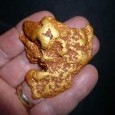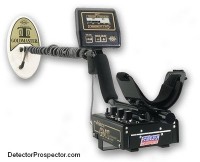
The White's GMT was released in 2000 and is still in production. The GMT has been the best-selling dedicated nugget detector in Alaska for many years. The combination of small gold finding ability, excellent depth on larger gold, and ease of use at a bargain price make it a hard unit to beat. I have used the GMT and its predecessor Goldmaster models to find thousands of gold nuggets in Alaska. See Thirty Years with White's Metal Detectors, White's Goldmaster GMT Rebuild and First Gold Nuggets Found with White's GMT for more information on my use of the GMT. See also Steve's Guide to White's Electronics GMT versus MXT. The GMT is one of only a few detectors available operating at more than 40 kHz (the GMT runs at 48 kHz), making it exceptionally sensitive to small gold nuggets.
The GMT is the latest in the new Goldmaster line of detectors that White's introduced in the early 1990's. The Goldmaster name is an old one, and White's produced many old BFO and IB/TR versions of the Goldmaster in the 60's and 70's. The early Goldmasters were old technology and did not ground balance, a key breakthrough in detector technology. These old models usually had large blue control boxes. If you see one of these for sale cheap do not confuse them with newer Goldmasters, all of which come in black boxes.
Note that in late 2018 White's introduced the 48 khz Goldmaster 24K. The GMT also remains in the lineup for now, but it is possible that the 24K will eventually replace the GMT.
The Goldmaster II was a serious breakthrough detector when it was introduced, operating at 50 kHz, far in excess of other ground balancing nugget detectors at the time, which commonly ran at 15-20 kHz. The Goldmaster II was quickly followed by the Goldmaster V/SAT, and these two models I credit with igniting a metal detector "gold rush" in Alaska. I got the ball rolling by finding thousands of gold nuggets at Crow Creek Mine south of Anchorage, and widely publicizing my discoveries. Crow Creek had produced few nuggets with detectors prior to the Goldmaster release, but the new 50 kHz design crossed a threshold where all of the sudden thousands of nuggets were large enough to be detected that were too small for previous detectors. White's simply could not build the new Goldmasters fast enough.
The Goldmaster V/SAT was followed by the Goldmaster 3 and raised the price from $499.95 to $599.95. White's then shifted gears and with the Goldmaster 4/B switched to using the control box design used by its coin machines. They also raised the price again to $699.95. This was not well received, and when Fisher introduced the Gold Bug 2 at about the same time for $775.00 Goldmaster sales plummeted.
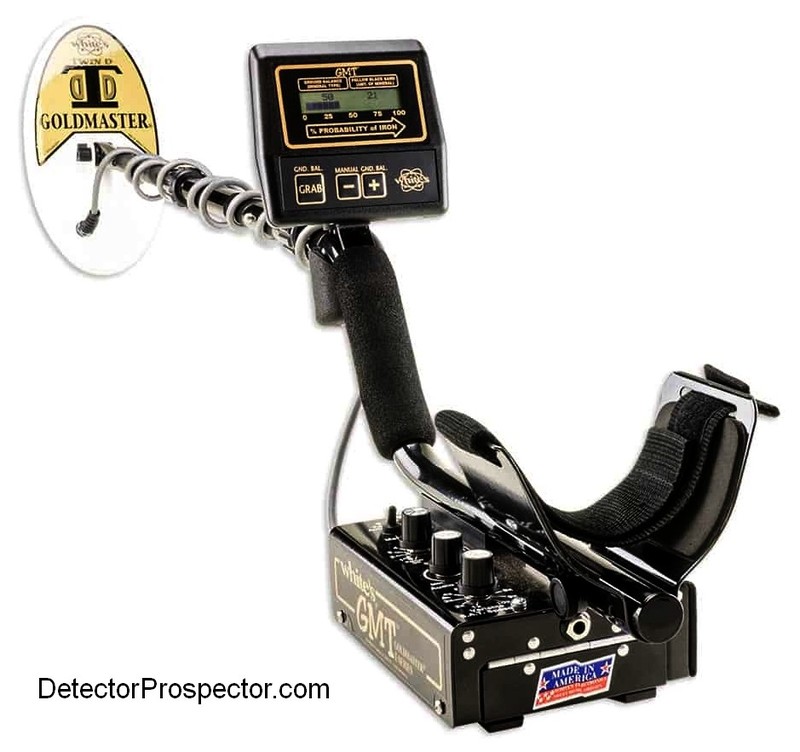
White's GMT 48 kHz gold nugget prospecting detector
The Goldmasters were all analog designs but a shift to digital began with the Goldmaster 4/B. White's started a project for a brand new detector design by hiring Dave Johnson, a well known engineer specializing in gold nugget designs, the ended up as the White's MXT. The GMT was as early spinoff of that project released a couple years before the MXT hit the market. The MXT Engineering guide linked to below tells the story in detail. A key design goal was to have automatic ground tracking, and so the Gold Master Tracker (GMT) was born. The new model also sported a new retail price of $799.95.
The GMT is a totally new design from the prior Goldmasters but seems very similar due to the goal of wanting it to be compatible with existing Goldmaster coils. In order to prevent "crosstalk" interference with existing Goldmaster models a 48 kHz operating frequency was chosen, which was still close enough to 50 kHz for old coils to work. However, the GMT was designed with DD coils in mind. Older Goldmasters all used concentric coils but the GMT shipped with a new 6" x 10" elliptical DD coil. One thing all the Goldmasters seriously lacked was a small coil option, and finally after the GMT was released White's came out with a small 4" x 6" coil, commonly referred to as the "Shooter". Much later yet, the concentric 8" x 14" Jimmy Sierra Gold Max coils were converted from concentric to DD. The concentric 8" x 14" coils were white and the newer DD versions are black.
White's is currently shipping only the new DD 4" x 6" Shooter, 6" x 10", and 8" x 14" Gold Max coils but until recently the only concentric coils available were the 6" x 10" and 8" x 14" coils on the used marketplace. White's in 2017 introduced a new round concentric coil for the GMT. The old concentric Gold Max coils are easy to identify - they have a white plastic housing whereas the new DD version is black. Concentric 6" x 10" coils are white plastic just like the new DD version, what differs is the decal. Any 6" x 10" Goldmaster coil not sporting the "Twin D" label is a concentric. The early decals came in red and black and later gold and variously were called the Long Scan, Gold Master II, Gold Master, and GM 3 coil. Beware of any round coils marked for use for the Goldmaster series. The only round coil ever produced that is compatible with the newer Goldmaster series is the 12" round Hot Shot coil pictured below. Any other round coils would be for the old "blue box" Goldmasters and will not work on the 48-50 kHz series.
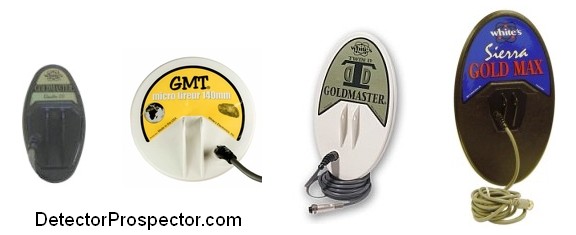
4"x6" Shooter DD coil, 6" round concentric, stock 6" x 10" DD coil for GMT, and 8" x 14" Sierra Gold Max DD coil
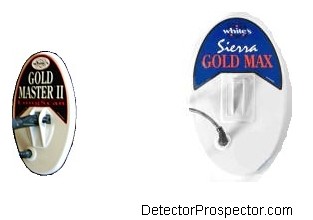
Old version 6" x 10" concentric and 8" x 14" concentric coils
The GMT currently has no aftermarket coils available. Jimmy Sierra used to market a couple coils that may be found on the used market. The Hot Shot was a round 12" concentric coil that in mild ground may have been the deepest coil made for the GMT but it suffered in mineralized ground due to the concentric design. Jimmy Sierra also marketed the 2.5" x 9" Hot Foot coil, a unique rectangular DD design. These coils were made by Jim Karbowski of Applied Creativity and marketed by Jimmy Sierra. Unfortunately Jim has passed away in 2007 and the manufacture of his coils with him.
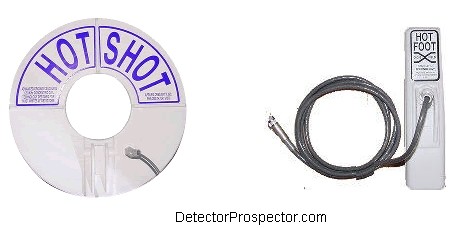
Applied Creativity Hot Shot and Hot Foot coils for GMT
As always, when designs shift from analog based to digital, there are always some who regard the analog designs as better in some way. A lot of people nostalgically remember the Goldmaster 3 as the best Goldmaster made. I do myself miss the old control box that could be converted to a hip or chest mount. However, the benefits of the GMT far outweigh any perceived faults. It was for a long time the only VLF nugget detector that allowed the operator to choose between automatic ground tracking and manual ground balance. The "Grab" button was an innovation only now being seen in other detector models over ten years later. The "follow the black sand" feature was also a unique though underutilized feature. The innovative "iron probability" ferrous identification system was unique for many years but has recently been copied by a couple other manufacturers.
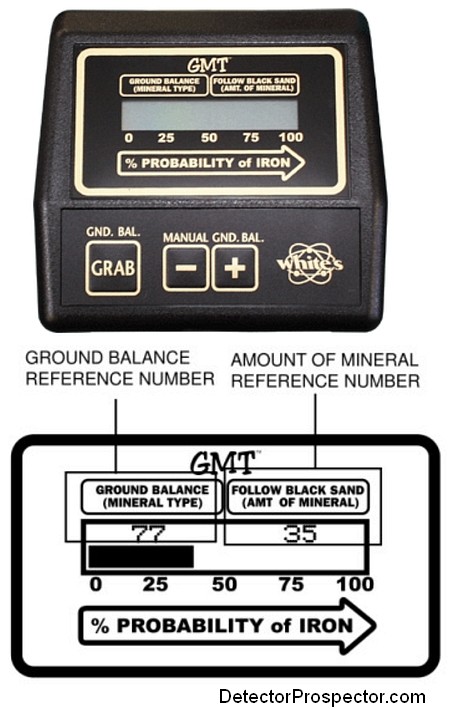
GMT meter pod and typical meter readings
The ground balancing options on the GMT are as good as they get. The unit can automatically track ground conditions and keep the machine as near optimum settings as possible. The GMT has what is regarded as one of the best ground tracking systems available. It has superior resolution, tracks faster, "jumps" into new ground more quickly, has greater resistance to tracking into targets, and tracks over a wider range of soil conditions. This is an obvious advantage for beginners who often have difficulty with manual ground balancing systems. It also benefits experts in locations where the ground varies constantly. This requires constant monitoring and adjustment on a manual system. It can place an undue burden on the operator and if ignored leads to the detector not being optimally tuned for the ground conditions. Simply set the ground balance toggle switch to "Fast AutoTrac®" and let the GMT handle the ground balancing chores. The GMT will automatically track and display the ground balance setting under the "Ground Balance (Mineral Type)" heading on the meter.
Ground balance tracking systems can "track into" a faint signal produced by a very small or very deep gold nugget and cause it to fade out as if it is a ground signal. This is especially likely if the operator hovers over the target after it is heard on the initial pass. For this reason the GMT trigger switch has a dual function. It engages the iron discrimination system but more importantly it temporarily locks out the ground tracking system. Whenever a faint target is encountered, squeeze and hold the trigger switch while working the target to insure the tracking system does not cause it to fade away.
While automatic ground tracking offers many benefits it can impede finding the very faintest targets. In extreme ground conditions the fact that the machine is constantly adjusting for ground conditions can actually impede a savvy operators ability to discern ground and target signals. Professional operators like having the option of using manual ground balance and the GMT accommodates this is a couple ways. There is the standard ability to toggle the ground balance switch to manual ground balance and then adjust the setting up or down via the plus and minus touch pads. One major benefit of manual ground balance is the ability to purposefully set the ground balance slightly off of the supposed perfect neutral ground balance setting. Many prospectors will set the ground balance slightly positive, or in other words such that the detector signals very slightly when the coil approaches the ground. This tends to prime the system to react more quickly to the faintest targets.
The GMT goes one step farther with the introduction of the ground "Grab" button. This unique GMT feature was long overlooked but is now being added as a feature on many other detectors. While in manual ground balance mode the tracking system continues to work in the background. Simply touching the Grab button on the meter touchpad instantly updates the ground balance to what the tracking software thinks is the best setting at that point in time. Pressing and holding the button engages the tracking system momentarily. This offers the best of both worlds in that a prospector can hunt in manual ground balance yet take advantage of the software to instantly update the setting instead of manipulating the plus and minus pads. The Grab button acts like an instant "Coarse Tune" control, which can then be tweaked slightly with the manual touch pad if desired. This is how I prefer to run my GMT most of the time. Run in manual, update with Grab when needed, and tweak if desired.
ads by Amazon...
The ferrous discrimination on the GMT is far more nuanced than on most detectors, with the meter giving an "iron probability" reading. A LCD bar graph reading starts on the left and builds to the right hand side of the readout and indicates the relative probability that the target is ferrous. A real plus on this system is it always reminds the operator that the ferrous indication is never 100% - there is always a chance that ferrous reading is a gold nugget. The system will never give a reading of higher than 90% or less than 10% ferrous probability. Most systems tend to lull the operator into thinking they are more accurate than they really are, causing gold nuggets to be erroneously identified as ferrous. The GMT forces the operator to analyze the target more thoroughly and when there is any doubt, to dig it. The meter also helps identify iron based "hot rocks".
In other words, most ferrous target systems are audio based, with a setting that may or may not be adjustable. Targets deemed ferrous on a single pass are ignored and the operator does not even know the target existed. The GMT alerts the operator to every target to make sure it is thoroughly checked out as a detector is often wrong about a target on a single off-center pass. The downside is that where targets are thick this constant analysis can place more of a burden on the operator than a system that can be set to silently ignore most trash targets.
Running the GMT with the trigger switch in the locked forward position engages an audio discrimination circuit that gives an audio "grunt" whenever the iron probability exceeds 85%. This can quickly identify likely iron target without having to refer to the meter. This is a momentary indication that resets on each sweep of the target. It is normal for an operator to approach the target with a slightly different angle and speed on each sweep and so the iron probability indication will vary on each pass. The operator works the target and takes note of the reading on each pass to make a dig or no dig decision.
Squeezing the trigger activates a target analysis mode that automates this task for the operator. Each target response is accumulated and averaged building a more consistent response than that generated by the trigger forward setting. Targets will tend to consolidate and build either higher or lower probabilities with multiple passes. This does not mean the final reading is any more accurate however. A small nugget in highly mineralized soil will tend to read as ferrous, and relying on the analyze feature will give a false sense that the GMT is more confident in that erroneous ferrous response by accumulating and averaging many of them.
The fact is all ferrous identification systems suffer from the reality that some gold nuggets will read as ferrous if small enough or deep enough. High gain levels also increase the possibilities of inaccurate results. Some gold is actually in magnetite instead of quartz and can be picked up with a magnet! Nuggets of this type have a strong possibility of being identified as ferrous. Whenever possible a prospector should dig all targets. However, with practice a skilled operator of the GMT has a far more informative ferrous identification system at their disposal that if used properly will result if fewer gold nuggets being left behind as trash targets. Even if the GMT says the target is 90% probable ferrous it is still telling you it is a 10% chance it is gold. How lucky are you feeling?
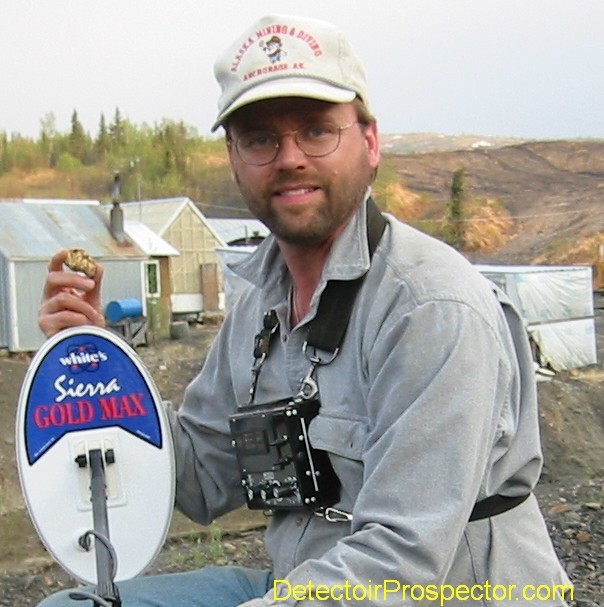
1.89 Oz nugget found with White's GMT chest mount conversion
The meter itself opens up many features lacking in detectors without a meter. The battery check reads out on the probability meter indicating the percent battery strength when the momentary toggle switch is activated. If the batteries are not fresh, audio loudness on big targets will not be as great, but there will be no loss of sensitivity or performance because the GMT is voltage regulated to run properly at less that peak battery voltage. You can rest assured the detector is working properly until the meter reads out "SORRY, LOW BATT". Be sure to have backup batteries ready to change out when this occurs.
From the MXT Engineering Report referenced below "The GMT's circuitry broke a lot of new ground. It uses a reactive impedance transformation network to boost transmitter voltage for higher sensitivity. It uses an active transmitter regulator to keep transmitter voltage constant even when the search coil is moved over black sand that would blow an unregulated machine off the air." What this means is many detectors can actually go completely non-functional when operated over extremely mineralized ground and the operator will not even be aware of it. The GMT is very resistant to this occurring, but if it does the detector will give a loud audio "squawk" and the meter will read "BAD GROUND REDUCE GAIN". The GMT literally tells you your gain is set too high for the ground condition. Set the control lower until this message goes away for optimum performance.
The GMT can also overload on shallow oversize targets in which case the meter will display "METAL TOO CLOSE LIFT SEARCH COIL". The overload condition will correct itself when the coil is moved away from direct proximity to the large metal item. There actually are gold nuggets large enough to overload a GMT so find out what the item is!
The GMT constantly displays the ground balance setting, typically in the 70-80 range. This number is telling you what type of mineralization is affecting the GMT and is very much akin to the target VDI number displayed on coin detectors except that here it is a ground reading. The GMT goes one step father and also displays the amount of the mineral being detected. This is called the "Follow Black Sand" reading because it can be used to trace shallow black sand deposits that in turn can be used to locate gold deposits. A reference number in the upper right portion of the display shows this value. The number grows as the coil is pumped up and down over concentrations of black sand. The readings are relative so the idea is to take readings at various locations across a dry wash for example, and then to focus on the highest readings as being the probable location of a black sand deposit.
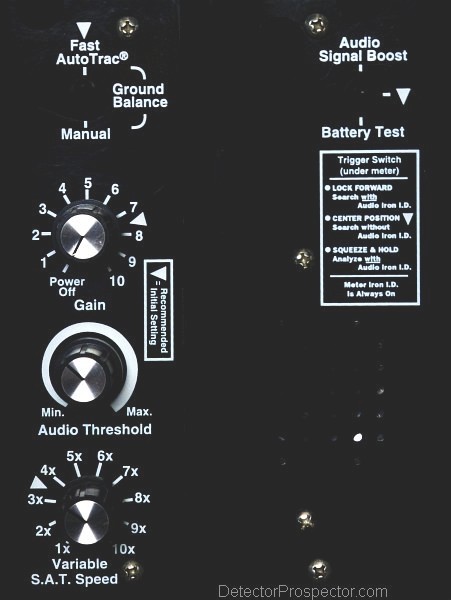
White's GMT control panel
When White's introduced the Goldmaster V/SAT it featured "Variable Self Adjusting Threshold" or V/SAT. The Goldmasters were the only nugget detectors for many years that allowed you to vary the rate at which the threshold readjusts itself via a variable control - anything from very fast to very slow. This allows for more control in varying situations. In general, use the lowest SAT setting that allows for smooth operation. As ground variations increase, setting a higher self adjusting threshold can be beneficial. At low settings, the coil can be swept slower without responses being overly smoothed out. High settings demand a faster sweep rate as the detector adjusts rapidly to bring the threshold back to the level set by the threshold control knob. See Steve's Guide to Threshold Autotune, SAT & V/SAT for more details.
Finally, the GMT offers an optional Audio Boost setting that amplifies the audio by up to four times. This makes faint signals louder but in bad ground can also amplify ground noise. Still, this is an extremely useful function for eking faint targets out of the ground.
All these features added up to the GMT being vastly more popular than the Goldmaster 4/B that preceded it. The GMT remains a best seller to this day. The bottom line is the GMT bears serious consideration for anyone wanting a detector solely for gold nugget detecting. Although the GMT is intended solely as a prospecting unit, it is very popular with meteorite hunters, and it is also one of the best micro-jewelry detectors on the market.
White's GMT Instruction Manual
Forum Threads Tagged "whites goldmasters-gmt"
Read the MXT Engineering Report - Features some important notes on GMT design
| Internet Price | $729 |
| Technology | Induction Balance (IB) |
| Frequency | 48 kHz |
| Autotune Mode(s) | Variable Self Adjusting Threshold (V/SAT) |
| Ground Rejection | Tracking, Fixed & Manual w/Grab function |
| Soil Adjust | No |
| Discrimination | Visual & Audio Ferrous ID |
| Volume Control | No |
| Threshold Control | Single turn control |
| Tone Adjust | No |
| Audio Boost | Yes |
| Frequency Offset | No |
| Pinpoint Mode | No |
| Audio Output | 1/4" headphone socket & speaker |
| Hip Mount | Shaft Mount Only |
| Standard Coil(s) | 6" x 10" DD Coil |
| Optional Search Coils | Three accessory coils available |
| Battery | Eight AA |
| Operating Time | 30 - 40 hours |
| Weight | 3.9 pounds |
| Additional Technology | One of the first detectors to measure mineralization "amount" instead of "type" |
| Notes |
*Notes on Technical Specifications - Detailed notes about the specifications listed in this chart.
-
 4
4



